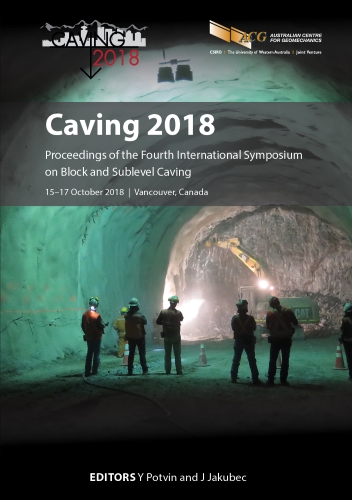Tracking cave shape development with microseismic data

|
Authors: Lynch, R; Meyer, S; Lotter, E; Lett, J |
DOI https://doi.org/10.36487/ACG_rep/1815_43_Lynch
Cite As:
Lynch, R, Meyer, S, Lotter, E & Lett, J 2018, 'Tracking cave shape development with microseismic data', in Y Potvin & J Jakubec (eds), Caving 2018: Proceedings of the Fourth International Symposium on Block and Sublevel Caving, Australian Centre for Geomechanics, Perth, pp. 555-564, https://doi.org/10.36487/ACG_rep/1815_43_Lynch
Abstract:
Microseismic monitoring is routinely used by block and panel caving mines worldwide to track cave shape development. The standard practice is to use the cloud of seismic event locations as a proxy for cave growth below. Careful seismic sensor array planning overcomes problems with event location reliability due to seismicray bending around the unknown cave. However, the aseismic gap – the (unknown) zone between actual cave back and bottom of the seismic event cloud – complicates estimation of cave geometry. More information than simple seismic event locations can be used to infer the cave shape and position. Since seismic events slip according to the stresses acting locally at the source locations, an analysis of source mechanisms yields indications of principal stresses around the cave. These stresses are the result of the virgin stresses perturbed by the cave shape, and this yields information about the cave shape. The apparent seismic wave arrivals under the straightray assumption are retarded when rays bend around the cave. These anomalous travel times are used to create 'spaghetti' – 3D curved lines indicating the likely ray path followed. Analysis of these curved rays in space and time suggests where the cave is and where it is growing. All of this indirect information is now routinely used at Cadia East mine in Australia to estimate the cave shape, helping geotechnical engineers to better manage the cave. A direct verification of the estimated cave shape with an open hole drilled to the cave back in early 2017 provided some validation of these seismic data techniques.
Keywords: cave tracking, microseismic, source mechanisms, travel times
References:
Cumming-Potvin, D, Wesseloo, J, Jacobsz, SW & Kearsley, E 2016, ‘Results from physical models of block caving’, Proceedings of MassMin 2016, The Australasian Institute of Mining and Metallurgy, Melbourne, pp. 329–340.
Duplancic, P & Brady, BH 1999, ‘Characterisation of caving mechanisms by analysis of seismicity and rock stress’, in G Vouille & P Berest (eds), Proceedings of Ninth Congress International Society for Rock Mechanics, vol. 2, A.A. Balkema, Rotterdam, pp. 1049–1053
Duplancic, P 2001, Characterisation of Caving Mechanisms Through Analysis of Stress and Seismicity, PhD thesis, The University of Western Australia.
Glazer, SN & Hepworth, N 2005, ‘Seismicity induced by cave mining, Palabora experience’, in Y Potvin & M Hudyma (eds), Proceedings of the Sixth International Symposium on Rockbursts and Seismicity in Mines, Australian Centre for Geomechanics, Perth, pp. 281–290.
Lett, JL & Capes, GW 2012, ‘Characterisation of caving and subsidence for operational enhancements at the Newcrest Ridgeway Gold Mine’, Proceedings of MassMin 2012, Canadian Institute of Mining, Metallurgy and Petroleum, Westmount.
Lett, JL, Brunton I, Capes, GW, Jäger, A, Mobilio, B, Rachocki, J, Sharrock, GB & Secheny, M 2016, ‘Undercutting to surface breakthrough – Cadia East panel cave (stage 1)’, Proceedings of MassMin 2016, The Australasian Institute of Mining and Metallurgy, Melbourne, pp. 65–81.
Lynch, RA 2010, Keynote Address: Passive and Active Microseismic Monitoring in Mines, presented at the Fifth International Seminar on Deep and High Stress Mining, hosted by the Australian Centre for Geomechanics.
Lynch, RA 2016, ‘Active and passive seismic monitoring of cave front evolution’, Proceedings of MassMin 2016, The Australasian Institute of Mining and Metallurgy, Melbourne, pp. 217–224.
Lynch, RA, Olivier, G & Green, MT 2013, ‘High accuracy measurements of seismic velocity variations in mines’, in A Malovichko &
D Malovichko (eds), Proceedings of the Eighth International Symposium on Rockbursts and Seismicity in Mines, GS RAS &
MI UB RAS, Obninsk-Perm, pp. 157–165.
Mendecki, AJ 1997, Seismic Monitoring of Mines, Chapman-Hall, London.
Mercier, JP, de Beer, W, Mercier, JP & Morris, S 2015, ‘Evolution of a block cave from time-lapse passive source body-wave traveltime tomography’, Geophysics, vol. 80, no. 2, pp. WA85–WA97.
Olivier, G, Brenguier, F, Campillo, M, Lynch, RA & Roux, P 2015, ‘Body-wave reconstruction from ambient seismic noise correlations in an underground mine’, Geophysics, vol. 80, no. 3, pp. 1–15.
Westman, E, Luxbacher, K & Schafrik, S 2012, ‘Passive seismic tomography for three-dimensional time-lapse imaging of mining-induced rock mass changes’, The Leading Edge, vol. 31, no. 3, pp. 338–345.
© Copyright 2025, Australian Centre for Geomechanics (ACG), The University of Western Australia. All rights reserved.
View copyright/legal information
Please direct any queries or error reports to repository-acg@uwa.edu.au
View copyright/legal information
Please direct any queries or error reports to repository-acg@uwa.edu.au
